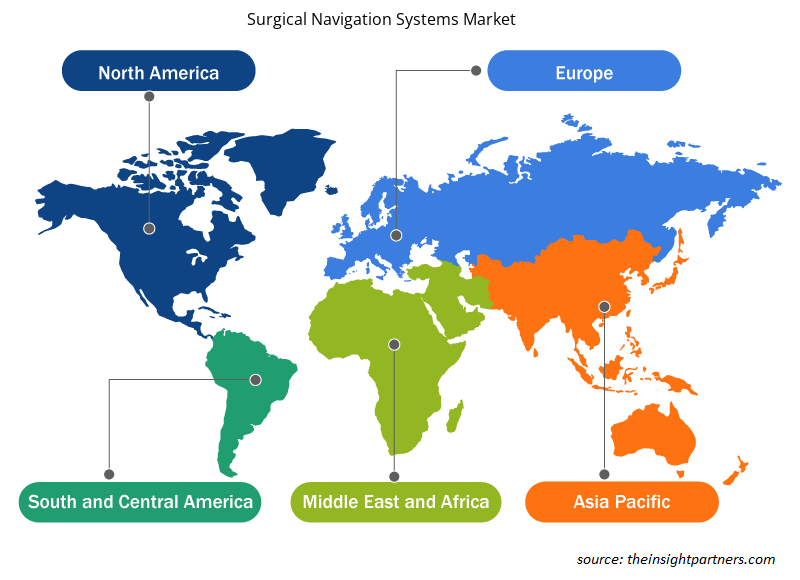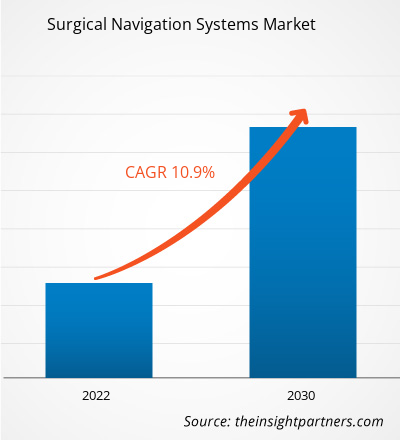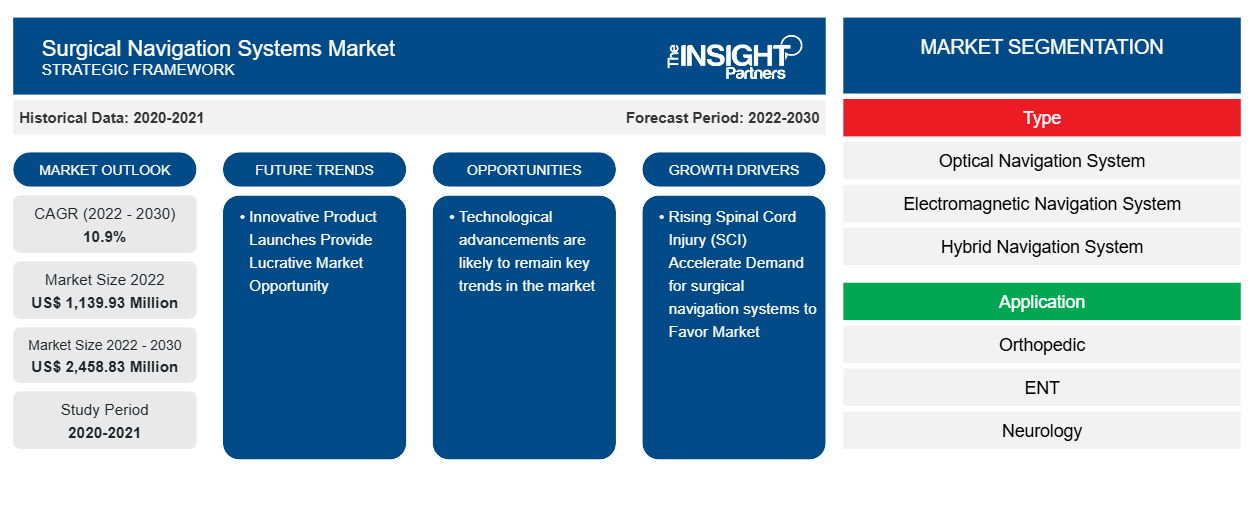Der Markt für chirurgische Navigationssysteme soll von 1.139,93 Millionen US-Dollar im Jahr 2022 auf 2.458,83 Millionen US-Dollar im Jahr 2030 wachsen; von 2022 bis 2030 wird eine durchschnittliche jährliche Wachstumsrate (CAGR) von 10,09 % erwartet. Technologische Fortschritte werden voraussichtlich weiterhin die wichtigsten Trends auf dem Markt bleiben.
Marktanalyse für chirurgische Navigationssysteme
Innovative, technologisch fortschrittliche Produkteinführungen werden in den kommenden Jahren lukrative Möglichkeiten für das Marktwachstum von chirurgischen Navigationssystemen bieten. Darüber hinaus beschleunigen Fortschritte bei der Operationsplanung und -navigation für Tumorbiopsien und -resektionen die Nachfrage nach chirurgischen Navigationssystemen, die das Marktwachstum vorantreiben werden. Brainlabs „Cranial Navigation“ ist ein Beispiel dafür. So hilft die „Cranial Navigation Angio“ Chirurgen beispielsweise dabei, zuführende und abführende Venen auf navigierten Daten der digitalen Subtraktionsangiographie (DSA) zu identifizieren oder ein Nidus-Objekt mit speziellen Ansichtslayouts zu lokalisieren. Brainlabs „Disposable Stylet“ ist für die Navigation bei der Platzierung von Shunts oder Ventrikelkathetern in der Neurochirurgie konzipiert und ermöglicht eine freihändige Platzierung. Außerdem erleichtert die „Cirq Alignment Software“ die intuitive manuelle Armpositionierung, wobei das Robotermodul eine automatische Ausrichtung der Flugbahn durchführt. Die oben genannten Faktoren wirken als einflussreicher Faktor, der für ein beträchtliches Marktwachstum in den Jahren 2021–2031 verantwortlich ist. Technologische Fortschritte werden wahrscheinlich weiterhin wichtige Trends auf dem Markt bleiben.
Marktübersicht für chirurgische Navigationssysteme
Auf Augmented Reality (AR) basierende chirurgische Navigationssysteme werden in der minimalinvasiven Chirurgie häufig eingesetzt. Die „Augmented Reality Surgical Navigation Technology“ von Philips ist ein Beispiel, das weiterentwickelt wird, um zusätzliche Möglichkeiten zur Verwaltung der Röntgendosis zu schaffen. Die Technologie verwendet hochauflösende optische Kameras, die in den Flachbildschirm-Röntgendetektor integriert sind , um Bilder der Patientenoberfläche aufzunehmen. Die AR-basierte Technologie des chirurgischen Navigationssystems kombiniert außerdem die von den Kameras aufgenommene Außenansicht und die vom Röntgensystem erfasste 3D-Innenansicht des Patienten und erstellt so eine 3D-AR-Ansicht der äußeren und inneren Anatomie des Patienten. Eine solche Echtzeit-3D-Ansicht der Wirbelsäule des Patienten soll die Verfahrensplanung und die Navigation der chirurgischen Instrumente verbessern und die Verfahrensdauer verkürzen.
Passen Sie diesen Bericht Ihren Anforderungen an
Sie erhalten kostenlos individuelle Anpassungen an jedem Bericht, einschließlich Teilen dieses Berichts oder einer Analyse auf Länderebene, eines Excel-Datenpakets sowie tolle Angebote und Rabatte für Start-ups und Universitäten.
- Holen Sie sich die wichtigsten Markttrends aus diesem Bericht.Dieses KOSTENLOSE Beispiel umfasst eine Datenanalyse von Markttrends bis hin zu Schätzungen und Prognosen.
Treiber und Chancen auf dem Markt für chirurgische Navigationssysteme
Steigende Rückenmarksverletzungen (SCI) beschleunigen die Nachfrage nach chirurgischen Navigationssystemen und begünstigen den Markt
Laut dem Bericht 2024 der United Spinal Association sind Menschen mit Rückenmarksverletzungen (SCI) einem hohen Risiko ausgesetzt, Druckverletzungen zu entwickeln, die auftreten, wenn das darunter liegende Gewebe durch Blutverlust beschädigt wird. So leiden beispielsweise bis zu 80 % der Menschen mit SCI einmal in ihrem Leben an Druckgeschwüren. Darüber hinaus leiden 65–78 % der SCI-Bevölkerung an Spastik, unkontrollierter Anspannung und Kontraktion der Muskeln. Angesichts der steigenden Inzidenz von SCI handelt es sich daher um einen medizinischen Notfall, der sofort behandelt werden muss. Bei der chirurgischen Behandlung von SCI ist es für Chirurgen jedoch eine Herausforderung, die genaue Operationsstelle zu lokalisieren. Das „StealthStation S8 Surgical Navigation System“ von Medtronic ist ein Beispiel dafür. Das „StealthStation S8 Surgical Navigation System“ umfasst ein Portfolio von über 200 navigierten Instrumenten, die das einzigartige integrierte „Stealth-Midas“ bieten und die Navigationsgenauigkeit auf ein neues Niveau bringen, insbesondere bei anspruchsvollen und beweglichen Anatomien in der Halswirbelsäule. Daher beschleunigt die Zunahme der Fälle von Rückenmarksverletzungen die Nachfrage nach chirurgischen Navigationssystemen und ist der Haupttreiber des weltweiten Marktanteils chirurgischer Navigationssysteme .
Innovative Produkteinführungen bieten lukrative Marktchancen
- Im August 2023 gab Orthofix Medical Inc. den ersten erfolgreichen Abschluss des ersten Falls in den USA mithilfe des fortschrittlichen „7D FLASH Navigation System Percutaneous Module 2.0“ bekannt. Das Percutaneous Module 2.0 bietet neue Planungsfunktionen und eine erweiterte Funktionalität für das 7D FLASH-Navigationssystem, sodass Orthofix die minimalinvasive Chirurgie (MIS) der Wirbelsäule durchführen kann.
- Im Juli 2023 kündigte Stryker die Einführung des „Q Guidance System“ mit Cranial Guidance Software an, das Chirurgen ein bildbasiertes Planungs- und intraoperatives Führungssystem bietet, das bei der Positionierung von Instrumenten und der Identifizierung der Patientenanatomie während der Schädelchirurgie hilft. Diese Software kann für Kraniotomien, Schädelbasis- und transsphenoidale Eingriffe, Shunt-Platzierungen und Biopsien verwendet werden.
Daher ist davon auszugehen, dass die Markteinführung innovativer Produkte einen positiven Einfluss auf den Markt für chirurgische Navigationssysteme haben wird, da sie die Möglichkeit zur Entwicklung technologisch fortschrittlicher chirurgischer Navigationssysteme bietet.
Segmentierungsanalyse des Marktberichts für chirurgische Navigationssysteme
Wichtige Segmente, die zur Ableitung der Marktanalyse für chirurgische Navigationssysteme beigetragen haben, sind Typ, Anwendung und Endbenutzer.
- Nach Typ ist der Markt für chirurgische Navigationssysteme segmentiert in optische Navigationssysteme, elektromagnetische Navigationssysteme, hybride Navigationssysteme, Fluoroskopie-Navigationssysteme, CT-basierte Navigationssysteme und andere. Das Segment elektromagnetischer Navigationssysteme hatte im Jahr 2022 den größten Marktanteil.
- Nach Anwendung ist der Markt in Orthopädie, HNO, Neurologie, Zahnmedizin und andere unterteilt. Das orthopädische Segment hatte im Jahr 2022 den größten Marktanteil.
- Nach Endverbraucher ist der Markt in Krankenhäuser, ambulante chirurgische Zentren und andere unterteilt. Das Krankenhaussegment hatte im Jahr 2022 den größten Marktanteil.
Marktanteilsanalyse für chirurgische Navigationssysteme nach Geografie
Der geografische Umfang des Marktberichts zu chirurgischen Navigationssystemen ist hauptsächlich in fünf Regionen unterteilt: Nordamerika, Asien-Pazifik, Europa, Naher Osten und Afrika sowie Süd- und Mittelamerika.
Nordamerika dominiert den Markt. In der Region Nordamerika haben die USA den größten Anteil am Markt für chirurgische Navigationssysteme. Die Präsenz führender Hersteller in der Region und ihre innovativen, technologisch fortschrittlichen chirurgischen Navigationssysteme sind die Faktoren, die zur Dominanz des Marktes beitragen. Der asiatisch-pazifische Raum wird in den kommenden Jahren voraussichtlich die höchste durchschnittliche jährliche Wachstumsrate aufweisen.
Regionale Einblicke in den Markt für chirurgische Navigationssysteme
Die regionalen Trends und Faktoren, die den Markt für chirurgische Navigationssysteme während des Prognosezeitraums beeinflussen, wurden von den Analysten von Insight Partners ausführlich erläutert. In diesem Abschnitt werden auch die Marktsegmente und die Geografie für chirurgische Navigationssysteme in Nordamerika, Europa, im asiatisch-pazifischen Raum, im Nahen Osten und Afrika sowie in Süd- und Mittelamerika erörtert.

- Erhalten Sie regionale Daten zum Markt für chirurgische Navigationssysteme
Umfang des Marktberichts zu chirurgischen Navigationssystemen
| Berichtsattribut | Details |
|---|---|
| Marktgröße im Jahr 2022 | 1.139,93 Millionen US-Dollar |
| Marktgröße bis 2030 | 2.458,83 Millionen US-Dollar |
| Globale CAGR (2022 - 2030) | 10,9 % |
| Historische Daten | 2020-2021 |
| Prognosezeitraum | 2022–2030 |
| Abgedeckte Segmente | Nach Typ
|
| Abgedeckte Regionen und Länder | Nordamerika
|
| Marktführer und wichtige Unternehmensprofile |
|
Marktteilnehmerdichte: Der Einfluss auf die Geschäftsdynamik
Der Markt für chirurgische Navigationssysteme wächst rasant, angetrieben durch die steigende Nachfrage der Endnutzer aufgrund von Faktoren wie sich entwickelnden Verbraucherpräferenzen, technologischen Fortschritten und einem größeren Bewusstsein für die Vorteile des Produkts. Mit steigender Nachfrage erweitern Unternehmen ihr Angebot, entwickeln Innovationen, um die Bedürfnisse der Verbraucher zu erfüllen, und nutzen neue Trends, was das Marktwachstum weiter ankurbelt.
Die Marktteilnehmerdichte bezieht sich auf die Verteilung der Firmen oder Unternehmen, die in einem bestimmten Markt oder einer bestimmten Branche tätig sind. Sie gibt an, wie viele Wettbewerber (Marktteilnehmer) in einem bestimmten Marktraum im Verhältnis zu seiner Größe oder seinem gesamten Marktwert präsent sind.
Die wichtigsten auf dem Markt für chirurgische Navigationssysteme tätigen Unternehmen sind:
- B. Braun SE
- DePuy Synthes Inc
- Medtronic
- Siemens Healthineers
- Stryker
- Zimmer Biomet
Haftungsausschluss : Die oben aufgeführten Unternehmen sind nicht in einer bestimmten Reihenfolge aufgeführt.

- Erhalten Sie einen Überblick über die wichtigsten Akteure auf dem Markt für chirurgische Navigationssysteme
Marktnachrichten und aktuelle Entwicklungen zu chirurgischen Navigationssystemen
Der Markt für chirurgische Navigationssysteme wird durch die Erhebung qualitativer und quantitativer Daten nach Primär- und Sekundärforschung bewertet, die wichtige Unternehmensveröffentlichungen, Verbandsdaten und Datenbanken umfasst. Nachfolgend sind einige der Entwicklungen auf dem Markt für chirurgische Navigationssysteme aufgeführt:
- Im Oktober 2022 kündigte SeaSpine Holdings Corporation die Produkteinführung des „7D FLASH Navigation System Percutaneous Spine Module“ an. Die Veröffentlichung des Percutaneous Module stellt eine neue Anwendung und erweiterte Funktionalität für das 7D FLASH Navigationssystem dar, wodurch SeaSpine weiter in die minimalinvasive Chirurgie vordringen kann. (Quelle: SeaSpine Holdings Corporation, Newsletter, Oktober 2022)
Marktbericht zu chirurgischen Navigationssystemen – Umfang und Ergebnisse
Der Bericht „Marktgröße und Prognose für chirurgische Navigationssysteme (2020–2030)“ bietet eine detaillierte Analyse des Marktes, die die folgenden Bereiche abdeckt:
- Marktgröße und Prognose für chirurgische Navigationssysteme auf globaler, regionaler und Länderebene für alle wichtigen Marktsegmente, die im Rahmen des Berichts abgedeckt sind
- Markttrends und Marktdynamiken für chirurgische Navigationssysteme wie Treiber, Einschränkungen und wichtige Chancen
- Detaillierte PEST/Porters Five Forces- und SWOT-Analyse
- Marktanalyse für chirurgische Navigationssysteme mit Blick auf wichtige Markttrends, globale und regionale Rahmenbedingungen, wichtige Akteure, Vorschriften und aktuelle Marktentwicklungen
- Branchenlandschaft und Wettbewerbsanalyse, einschließlich Marktkonzentration, Heatmap-Analyse, prominenten Akteuren und aktuellen Entwicklungen auf dem Markt für chirurgische Navigationssysteme
- Detaillierte Firmenprofile
- Historische Analyse (2 Jahre), Basisjahr, Prognose (7 Jahre) mit CAGR
- PEST- und SWOT-Analyse
- Marktgröße Wert/Volumen – Global, Regional, Land
- Branchen- und Wettbewerbslandschaft
- Excel-Datensatz
Aktuelle Berichte
Verwandte Berichte
Erfahrungsberichte
Grund zum Kauf
- Fundierte Entscheidungsfindung
- Marktdynamik verstehen
- Wettbewerbsanalyse
- Kundeneinblicke
- Marktprognosen
- Risikominimierung
- Strategische Planung
- Investitionsbegründung
- Identifizierung neuer Märkte
- Verbesserung von Marketingstrategien
- Steigerung der Betriebseffizienz
- Anpassung an regulatorische Trends























 Kostenlose Probe anfordern für - Markt für chirurgische Navigationssysteme
Kostenlose Probe anfordern für - Markt für chirurgische Navigationssysteme